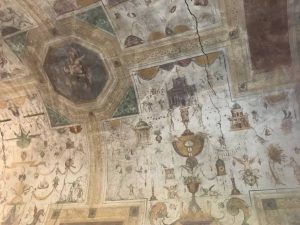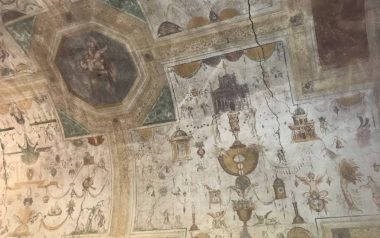Palace Lana
On the road to Bedizzole rises the portal that could be the announcement of a large palace: two long pilasters resting on the shoulders of the rusticated portal, an entablature with triglyphs broken in the middle to make room for a coat of arms shield surrounded by scrolls and cartocci, ultrabarocco, all this noise would seem to predict who knows what grandeur and instead, looking out at the very large courtyard, you can see a building with a colonic appearance even if the size is not common. Observe the beautiful well on the left.
Palace Lana (XVI century): In the interior of the unfinished palaces it is possible to see the remains of an ancient splendor. First of all, the entrance hall has a barrel vault, all painted in grotesques and friezes from the 16th century and the living room, which opens on the left as you enter it (today used as a dairy) as well as few traces of a beautiful frieze on the strip under the ceiling. wood, there is a beautiful stone fireplace, always from the sixteenth century, which bears the motto “ET CREAT ET PERDIT”, On the hood is painted a large coupled coat of arms of Lana and Ducco. There are other rooms at a time but without deoration, at least apparent.
On other occasions we have had the opportunity to talk about the Third and especially of third parties. In 1568 Celso (born 1534) with his brother Hannibal (born. 1527) the bandit without family, sons of Theseus q. Luca, possessed around 400 piò between Mazzano and Virle with various barns; the third brother Ercole (born 1530) does not report property in that place while Luca (born 1525) clearly states that he owns a house in Virle that is making. The property of Hannibal passed to Hercules and so in the seventeenth century all three branches descended from the sons of Theseus had properties in this area, in addition to the oldest of Borgonato etc. This house in 1641 was to be of the Celsus branch q. Theseus and precisely Fabrizio (born 1578), who must have left it to the sons of his brother Ferrante, named Celso (born 1631) and Gio. Battista (born 1641). Celso was the son of Ferrante’s first wife, that is Taddea Calini, Gio. Battista of the second, Dorotea Alventi. Celso lived in Brescia at Novarino and Gio. Battista in the district of Porta Nuova (v. G. Rosa) towards the canton of Bruttanome. Ferrante (born 1665) Fabrizio (born 1667) and Teseo (born 1678) were born from Gio. Battista and Ottavia Avoltori, near the countryside; the latter married Lodovica Emili q. Antonio, other neighbors in the country, but had no children and the property, perhaps for the fidecissier bond, passed to the descendants of the collateral branch always of the lineage of Theseus (q. Luca) and coiè Gio. Pietro (born 1678) q. Ascanio q. Carlo. From Gio. Pietro and from the nob. Costanza Fenaroli were born many children, among whom arose a long and famous dispute over the divisions of the paternal property but they continued the family only in two: Ignazio (born 1724) about which we spoke about the villa of Borgonato and Gaetano. He married Marianna Giudici and they gave birth to Giovanni, husband of Giulia Bona and father of Gaetano (1816 – 1881). From his wife Francesca Guidinali, Gerardo was born (born 1854 – died 1908) who sold the property of Mazzano. He was the last male of the whole de Terzi Lana family because his wife Evelilna Tocagni had only three daughters Olga, Eva and Bianca. Eva married Mr. Ragnoli. The house, called La Maddalena, passed into various properties increasingly decaying from its rank of noble residence.
 Palace Lana
Palace Lana
Palace Lana – Fonti Fausto Lechi, “Dimore Bresciane, in cinque secoli di storia”

